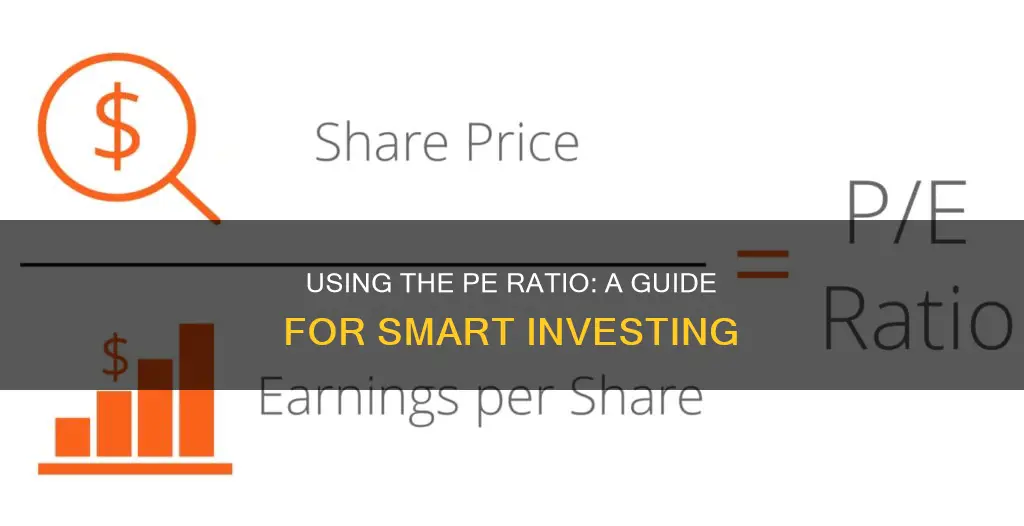
The price-to-earnings (P/E) ratio is a key metric used by investors and analysts to determine the valuation of a stock or index. It compares a company's stock price to its earnings per share (EPS), indicating whether a stock is undervalued or overvalued. A high P/E ratio suggests a stock's price is high relative to its earnings, while a low P/E ratio indicates the opposite. The P/E ratio is calculated by dividing the market value price per share by the company's EPS. It is a useful tool for investors to identify undervalued stocks, compare stocks within the same industry, and make informed investment decisions.
| Characteristics | Values |
|---|---|
| Purpose | To determine stock valuation, i.e., whether a company's stock price is overvalued or undervalued |
| Calculation | Market value per share / Earnings per share |
| Comparison | Used to compare similar companies in the same industry or sector |
| Benchmarking | Used to compare a company's valuation against its historical performance, or against a benchmark like the S&P 500 Index |
| Growth Prospects | A high P/E ratio could indicate a company's stock is overvalued or that investors expect high growth rates |
| Limitations | Does not account for future earnings growth, can be influenced by accounting practices, and may not be comparable across different industries |
What You'll Learn

How to calculate the PE ratio
The price-to-earnings (P/E) ratio is a common metric used by investors and analysts to determine the relative value of a company's stock. It is calculated by dividing the current market price of a stock by its earnings per share (EPS).
Step 1: Determine the Share Price
The share price is the current market price of the stock, which can be found by searching the stock's ticker on a reputable financial website. This information reflects what investors are currently paying for the stock.
Step 2: Calculate the Earnings Per Share (EPS)
The EPS is the amount of a company's profit allocated to each outstanding share of common stock. It is calculated by dividing the company's net income by the total number of diluted shares outstanding.
Step 3: Divide the Share Price by the EPS
To calculate the P/E ratio, divide the share price by the EPS. This will give you the relative value of the company's stock.
For example, if a company's stock is trading at $100 per share and its EPS is $4, the P/E ratio would be 25 ($100 / $4). This means that, given the company's current earnings, it would take 25 years of accumulated earnings to equal the cost of the investment.
It is important to note that the P/E ratio can be calculated using different variations of EPS, such as trailing twelve-month (TTM) earnings or forward earnings estimates. Additionally, the P/E ratio should be compared with other companies in the same industry or the company's historical P/E range to determine if a stock is overvalued or undervalued.
A Beginner's Guide to ETF Investing with Fidelity
You may want to see also

How to interpret the PE ratio
The price-to-earnings (P/E) ratio is a key metric used by investors and analysts to determine whether a stock is overvalued or undervalued. It compares a company's stock price to its earnings per share (EPS). The P/E ratio is calculated by dividing the market value price per share by the company's EPS.
Interpreting the P/E ratio involves understanding how the market values a stock relative to its earnings. Here are some key points to consider when interpreting the P/E ratio:
- High P/E Ratio: A high P/E ratio indicates that a stock's price is high relative to its earnings, and it may be overvalued. This could be due to high growth expectations, and investors are willing to pay a premium anticipating future growth. However, if the company fails to meet these expectations, the stock may be seen as overvalued, and its price may reverse as investor confidence decreases.
- Low P/E Ratio: A low P/E ratio suggests that the current stock price is low compared to earnings, and the stock may be undervalued. If the company's growth exceeds expectations, the stock may be considered a bargain, attracting more buyers.
- Sector and Industry Comparison: P/E ratios vary across different sectors and industries. For example, software companies typically have higher P/E ratios due to expected rapid growth, while insurance companies often have lower P/E ratios as they are not expected to grow as fast. It is essential to compare P/E ratios within the same sector or industry, as it is industry-specific.
- Growth vs. Value Investments: P/E ratios help define stocks as either growth or value investments. Stocks with high P/E ratios attract growth investors who expect higher earnings growth, while stocks with low P/E ratios appeal to value investors who pay less for each dollar of earnings.
- Earnings and Growth Expectations: A high P/E ratio may signal that investors expect higher earnings growth in the future. On the other hand, a low P/E ratio could indicate that the market has pessimistic expectations for a company's future earnings.
- Trailing vs. Forward P/E: The calculation method for P/E ratios can impact their interpretation. The trailing P/E ratio uses a company's past 12 months of earnings and is the most commonly used method. The forward P/E ratio uses forecasted earnings and is useful for understanding how the market expects a company to perform in the coming year.
- Absolute vs. Relative P/E: The absolute P/E ratio represents the P/E over a 12-month period and is the most commonly used form. The relative P/E compares the current absolute P/E to a benchmark or past P/Es over a more extended period, providing a broader perspective.
- Limitations: It is important to consider the limitations of the P/E ratio. A high P/E ratio does not always mean a stock is overvalued, and a low P/E ratio does not guarantee that a stock is undervalued. Earnings can be manipulated, and there is a risk of inaccurate estimates when using projected earnings. It is advisable to use the P/E ratio as part of a more comprehensive analysis.
Fidelity Scanning for Value Investing: A Guide
You may want to see also

How to use the PE ratio to find undervalued stocks
The price-to-earnings (P/E) ratio is a widely used metric for investors and analysts to determine stock valuation. It is calculated by dividing the market value price per share by the company's earnings per share (EPS). A high P/E ratio may indicate that a stock's price is high relative to its earnings and possibly overvalued, while a low P/E ratio may suggest that the current stock price is low relative to earnings.
To find undervalued stocks using the P/E ratio, investors can compare stocks within the same industry or sector, as a good P/E ratio for one group may be poor for another. For example, software companies typically have higher P/E ratios than slow-growing utility companies. By comparing similar companies, investors can identify stocks that are potentially undervalued relative to their peers.
Additionally, investors can look for stocks within an industry expected to benefit from the economic cycle and identify companies with the lowest P/Es to determine the most undervalued stocks. This approach considers the broader economic context and can help identify sectors or industries that are poised to perform well.
It is also important to note that the P/E ratio has some limitations. For instance, it does not factor in future earnings growth, and historical earnings may not be indicative of future performance. Therefore, investors should consider using other ratios, such as the price-to-earnings-to-growth (PEG) ratio, which takes into account both the P/E ratio and the expected growth rate.
In summary, the P/E ratio is a valuable tool for investors to assess stock valuation and identify undervalued stocks, but it should be used in conjunction with other ratios and a comprehensive analysis of individual companies, industries, and the broader economic environment.
Cash Advance Investment Strategies: A Guide to Getting Started
You may want to see also

How to use the PE ratio to compare stocks
The price-to-earnings (P/E) ratio is a widely used metric that helps investors compare the valuations of individual stocks or entire stock indexes. It is calculated by dividing the current market price per share by the company's earnings per share (EPS). The P/E ratio helps investors determine the market value of a stock relative to the company's earnings and can indicate whether a stock is overvalued or undervalued.
When comparing stocks using the P/E ratio, it is important to consider the following:
- Sector and industry: Compare stocks within the same sector or industry as P/E ratios can vary widely across different sectors. For example, software companies typically have higher P/E ratios than slow-growing utility companies.
- Growth prospects: A high P/E ratio may signal that investors expect higher earnings growth in the future, making the stock attractive to growth investors. On the other hand, a low P/E ratio may indicate that the stock is undervalued and could be appealing to value investors.
- Absolute vs. relative P/E: The absolute P/E ratio represents the P/E over a 12-month period and is the most commonly used form. The relative P/E compares the current absolute P/E to a benchmark or past P/Es over a set period, providing a broader perspective.
- Forward vs. trailing P/E: The trailing P/E ratio uses a company's earnings over the past 12 months, while the forward P/E ratio uses forecasted earnings. The trailing P/E is the most widely used but may not reflect future earnings potential.
- Earnings growth: Consider the PEG (price/earnings-to-growth) ratio, which takes into account both the P/E ratio and the company's expected earnings growth rate. A PEG ratio lower than 1 may indicate that a stock is undervalued.
- Limitations: The P/E ratio has limitations and should not be the sole basis for investment decisions. It does not factor in future earnings growth, and historical earnings may not be indicative of future performance. Additionally, earnings can be manipulated or volatile, affecting the reliability of the P/E ratio.
In summary, the P/E ratio is a valuable tool for comparing stocks, but it should be used in conjunction with other analysis tools and considerations to make informed investment decisions.
Investing: Negative Cash Flow's Impact and Insights
You may want to see also

Limitations of the PE ratio
The price-to-earnings (P/E) ratio is a widely used metric for investors and analysts to determine stock valuation and compare companies within the same industry. However, it has several limitations that investors should be aware of:
- Volatile market prices: Short-term market volatility can impact the P/E ratio, making it less reliable for short-term investment decisions.
- Earnings makeup: Determining a company's earnings can be challenging, as the P/E ratio typically uses historical earnings, which may not be indicative of future performance. Investors are more interested in future earnings, which can be difficult to predict accurately.
- Forward earnings: Future earnings estimates may be overly optimistic or pessimistic, depending on economic conditions. They can also be affected by one-time adjustments, such as the sale of a subsidiary, which can complicate predictions.
- Earnings growth exclusion: The P/E ratio does not include earnings growth prospects, which can make it difficult to assess a company's true growth potential.
- Appropriate earnings number: Investors must determine how to define earnings and the factors that impact them, which can vary across industries.
- Infrequent earnings releases: Earnings are typically released quarterly, while stock prices fluctuate daily. This discrepancy can lead to a mismatch between the P/E ratio and a company's actual performance over time.
- Industry comparability: P/E ratios are most meaningful when comparing companies within the same industry, as valuation and growth rates can vary significantly between sectors.
- Accounting practices: The P/E ratio can be influenced by accounting practices and may not capture other financial aspects such as debt levels, cash flow, or the quality of earnings.
- Company profitability: Companies that are not profitable or have negative earnings pose a challenge for calculating P/E ratios, and there is no standard approach for dealing with these scenarios.
- Subjective earnings guidance: The P/E ratio relies on earnings information provided by the company, which may be subject to manipulation or inaccuracy.
Best Places to Safely Invest Your Cash
You may want to see also
Frequently asked questions
The PE (price-to-earnings) ratio is a metric used to compare a company's stock price to its earnings per share (EPS). It is calculated by dividing the current market value price per share by the company's EPS.
A high PE ratio may indicate that a company's stock is overvalued, while a low PE ratio may suggest that it is undervalued. However, it's important to compare PE ratios within the same industry or sector, as the ratios can vary widely between different sectors.
The PE ratio has its limitations and should not be the sole basis for investment decisions. It is based on historical data, which may not reflect future earnings. Additionally, earnings can be manipulated, and the ratio does not factor in future earnings growth.







